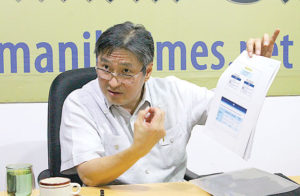The Philippine unit of the world’s largest aviation industry group International Air Transport Association (IATA) urged the Duterte Administration to give top priority to infrastructure development if it wants to benefit from record growth in commercial aviation in the Asia-Pacific region.
“The Asia-Pacific region is achieving an unprecedented growth rate in aviation. This growth rate is expected to continue in the coming decades, an observation backed up by large number of aircraft scheduled for future delivery to carriers in the region,” IATA-Philippines country manager Roberto Lim said during a roundtable discussion with The Manila Times on Thursday.
“Decision makers will have to understand that the Philippines will have to compete for it. They should have a mindset and make it a priority or come up with a policy [to boost flights and connectivity in the country],” Lim added.
A recent study commissioned by IATA showed that air travel in Asia will be greater than that of Europe and North America combined, rising to a total of 4.3 billion passengers within the next 20 years.
This growth is generating large regional economic impacts in aviation.
“Not only is the growth of Asia-Pacific air transport a major economic generator in its own right, the resulting increase in connectivity to/from and within the region facilitates economic growth and development in a wide spectrum of industries,” the study said.
IATA is the trade association for the world’s airlines, representing some 260 airlines or 85 percent of total air traffic.
As of 2014, it said, the economic impact of air transport--including direct, indirect and induced benefits--in Asia-Pacific alone was pegged at $705 billion with more than 33.7 million jobs generated.
By 2035, the aviation industry in the region is expected to contribute about $1.34 trillion and 72.3 million jobs.
In the Philippines, about 60 million passengers were recorded in 2014, which led to generation of 1.4 million direct and indirect jobs valued at $10 billion.
By 2035, the total number of passengers is expect to increase to 140 million, with 3.4 million jobs to be generated valued at $23 billion.
The study, however, assumed that none of the airports in the region and in the Philippines experienced any capacity constraints--including terminal or runway systems, airline and support service capacity and investments--are not restricted by policy or financing.
“Policy or financial constraints on development of aviation will reduce those economic benefits to around 48.5 million jobs and economic contribution of just $942 billion, compared to the benefit if aviation is unconstrained,” it said.
Lim noted that development of aviation infrastructure in the region is not keeping pace with growth in demand, putting some of the potential future economic benefits of aviation at risk.
He said they hope to hold audience with President-elect Rodrigo Duterte to lay down proposals and solutions to decongest the country’s main gatewa-- Ninoy Aquino International Airport (NAIA).
Among the immediate solutions was an open, transparent and constructive communication with stakeholders, optimizing the current capacity and throughput of NAIA, making investments and resources a priority again, improving use of techonolgy and resources and taking passenger experience into consideration, particularly elimination of long queues and inefficient processes.
Also, safety and operational concerns remained a tough challenge at NAIA, including “hot spots” or areas that have a massive potential for airplanes colliding.
Ground movement aids, air traffic controls procedures, airfield charts and obstacle and terrain surveys should be improved to keep pace with growth in demand.
For the long-term, Lim said there should be clear vision for the Metro Manila area--NAIA, Clark International Airport and New Manila Airport.
He added that the Duterte administration should be decisive and have the political will to start construction of the second Manila airport if he wants a smooth transition to living in Malacañang.
Duterte, a frequent flier himself, earlier said he plans to commute back and forth from Manila to Davao City every day until he has adjusted to living in Malacañang.
The incoming President will cease to be the mayor of Davao City in southern Philippines on June 30, when he takes his oath of office as the nation’s new leader.
A feasibility study on the second airport is currently underway, with two locations being considered, one having been identified as Sangley Point, Cavite, and the other one a possible reclamation site on Laguna de Bay.
Lim said the new airport for commercial flights should be located near Metro Manila and business centers, while small flights and cargo and transport planes should be relocated to other airports like Clark International Airport in Pampanga.
“There’s currently improper use of the scares resources. I think the new administration would want to solve this issue… this is no longer sectoral, but national,” he noted.


